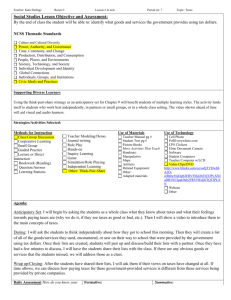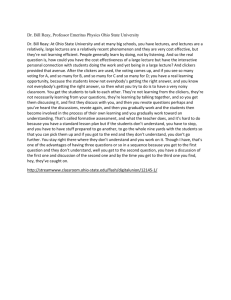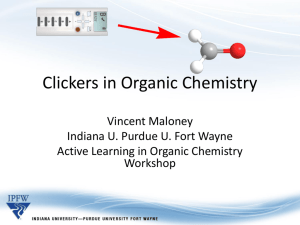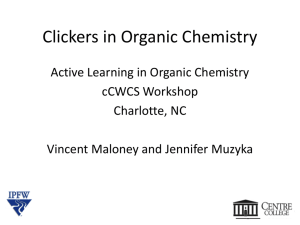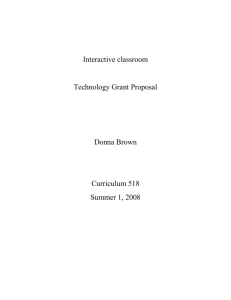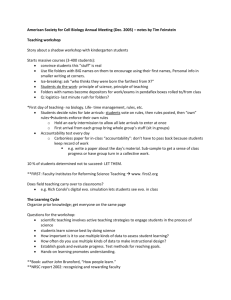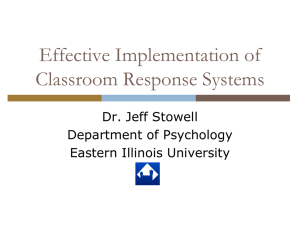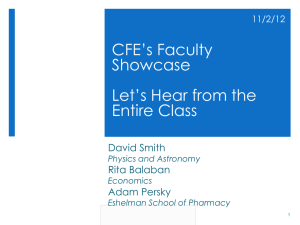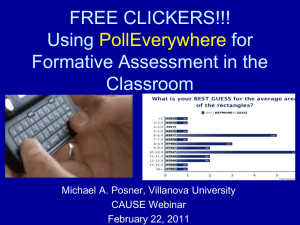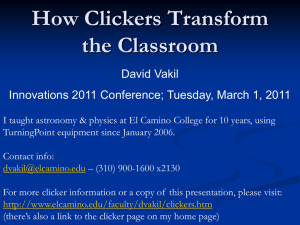clickers 2014
advertisement
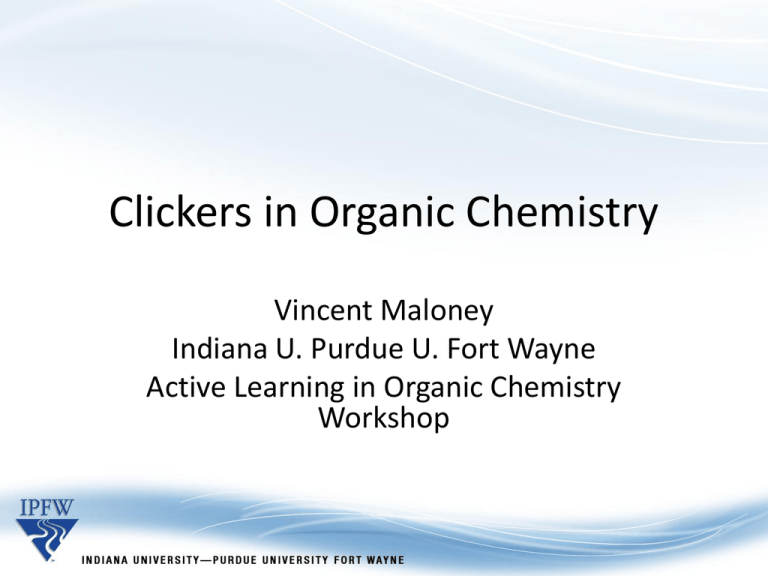
Clickers in Organic Chemistry Vincent Maloney Indiana U. Purdue U. Fort Wayne Active Learning in Organic Chemistry Workshop What is your experience with clickers? A. Have not tried them but am interested B. Use them occasionally C. Use them regularly D. Have not tried them but am unconvinced E. Opposed to their use 43% 25% 21% en us e 4% th ei r .. se d to bu t Op po th em re gu la ot tri ed th em ca s oc th em Us e Us e Ha v Ha v en ot tri ed th em bu t .. io na lly r ly 7% What barriers prevent you from adopting clickers? 31% 28% 13% 10% 10% 7% Co st to Co st Ti s ud tt m o en e d to t e pa le ar rtm n ne en t w so ftw Lo ss ... of c la ss tim Cl e ic k er us Ot er he /n r o ba rri er s A. Cost to student B. Cost to department C. Time to learn new software or adding questions D. Loss of class time E. Other F. Clicker user/no barriers Resources • Teaching with Classroom Response Systems by Derek Bruff, Jossey-Bass, 2009 • Clickers in Action: Active Learning in Organic Chemistry by Suzanne M. Ruder, Norton, 2013 – Suggested by J. Muzyka Why Clickers ? (Student Response Systems) • Technology for Classroom Assessment Techniques (CATs) • Variety of methods for obtaining immediate feedback of student knowledge and learning – before any quiz or exam where it’s “too late” Why Clickers ? • e.g. Ask a question based on material just covered in lecture – Have all students answer – Quickly check answers – Correct misconceptions/misunderstanding Benefits • Immediate feedback • All students respond • Anonymous to students – Instructor can determine who answered and how • Improve student learning • Grading? Benefits • Improve student learning – Thomas D’Angelo and K. Patricia Cross, Classroom Assessment Techniques: A Handbook for College Teachers, Jossey-Bass, 1993 – Bruff for clickers – David C. Haak, et al. Increased Structure and Active Learning Reduce the Achievement Gap in Introductory Biology, Science 332, 1213 (2011) – Louis Deslauriers, et al. Improved Learning in a LargeEnrollment Physics Class, Science, 332, 862, (2011) – Linda B. Nilson, Teaching at Its Best, Jossey-Bass, 2010, pp. 273 – 280 What are the pedagogical benefits of using clickers? 61% 39% Be de sc itu tte ra tt re te nt io 0% on ce rn Al .. . lo ft he ab ov e of s.. . 0% n of pr ov ed re te nt io Im ov ed pr n en ga g ov ed pr Im ... m em en t 0% Im A. Improved engagement B. Improved retention of material C. Improved retention of students (course/institution) D. Better attitudes concerning course and material E. All of the above Types of question • • • • • Review gen chem Assess retention of material Application of concept Inquiry/discovery-based learning Check attendance? Solving problems • Multi-step synthesis • Mechanisms • Spectral interpretation Question types • • • • Multiple choice Numerical Text Sources of questions – Instructor generated – Publisher generated – Student generated What is the major product of the reaction shown? A B C D 20% D C 8% B 4% A A. B. C. D. 68% CH 3 How many signals appear in the 13C NMR spectrum of the compound shown? 96% Responses 5 4 3 4 Values: 5 Value Matches: 0 Other 5 6 4% 4 Rank 1 2 What kind of isomers are these? Br Br H H H CH 3 30% CH 3 H 9% FI G er Ot h UR AT IO N AL M ER S CO N ST ER EO IS O DI AS TE RO M ER 4% M ER 4 STEREOISOMERS Values: 5 CONFIGURATIO... Value Matches: 0 6 Other 9% AS TE RE O DIASTEREOMERS DIASTEREOMER DIASTEROMER DI 1 2 3 22% M ER S Responses AS TE RE O Rank 26% trans DI cis How should the mechanism arrows be written? (Write a sequence of numbers. The 1st number is the base of a curved arrow. The second number is the head. If there is a second arrow, the 3rd number would be the base and the 4th number would be the head. 1 H 3C H 2C 3 2 4 S 5 6 C H 2C H 3 + H 3C 8 7 Br H 3C H 2C 91% S C H 2C H 3 CH3 Responses 3678 36 3 4 Values: 5 Value Matches: 0 6 Other 36 78 9% 36 Rank 1 2 B r- Propose a multi-step synthesis to convert cyclohexene to ethoxycyclohexane. 1 D 2O 2 6 H 2O 7 R an ey N i, E tO H - OD 1 1 H 2S O 4, H 2O HCl 12 N a 4 C l2 9 N aN H 2, N H 3 S O C l2 N 10 C H 3 C H 2 O - , C H 3 C H 2 O H , 87% 13 C H 3 C H 2 B r 14 P B r 3 Responses 111213 810 3 Values: 4 Value Matches: 0 5 Other 13% 11 12 13 6 5 81 0 Rank 1 2 8 3 M g, E t 2 O (Li, T H F ) OH 1 1 H 2S O 4, H 2O 12 N a O 1 3 C H 3C H 2B r C H 2C H 3 O- Synthesize 3-methylhex-3-ene from butan-2-ol and 1-bromopropane by entering the number for the correct reagents for the letters in the boxes. You will need to determine what Compounds U, V, and W along the way. Use each reagent only once. 1. (1. LiAlH4, ether 2. H3O+) 2. Na2Cr2O7, H2SO4 3. Compound V 4. Compound W 5. Ph3P 6. BuLi, ether 7. Mg, ether 8. NaOEt, EtOH O H 3C H2 C C CH3 Practices • Informal peer learning – Students discuss questions • How time for questions? – Varies, ~ 2 min. – Listen to level of conversation • What is the minimum number of questions suggested per 50 min. class period? – Varies, ~ 3 Practices • “Good” questions for peer learning – < 70% correct but >30% correct – Ask students to discuss with someone who disagrees and poll again • Easy questions (>80% correct) often given to avoid discouragement • Posting % responses – Can affect follow up polling Practices • Class participation points – e-mail reason for absence to avoid losing clicker points – No grade for % correct – Grade based on % correct – Combination of both Potential Issues • Choosing same answer as smartest person nearby • Random guessing • “Helping” absent friend • Exams and quizzes Logistics • Options for student use – Own – Share – Rent – Mobile device • Integration with PowerPoint Original Conventional Wisdom • Use one system across your institution – Decided by faculty and/ITS • Mobile devices – Hardware no longer consideration – Important considerations • • • • Cost Software Ease of use Where does data reside Drawing Structures • Mastering Chemistry: Pearson – Easier to check student responses in class – Draw structures and vote on them Acknowledgements • IPFW – CELT – ITS • Jennifer Muzyka and Centre College


